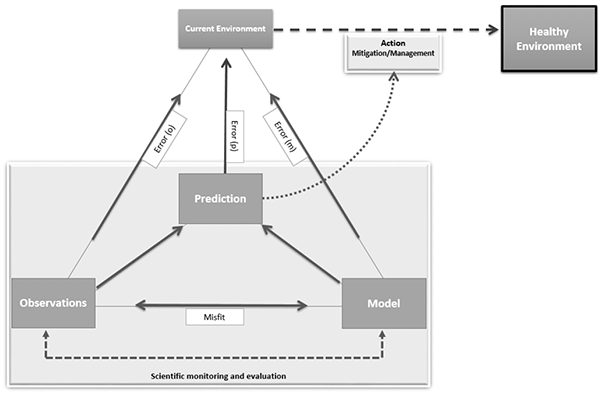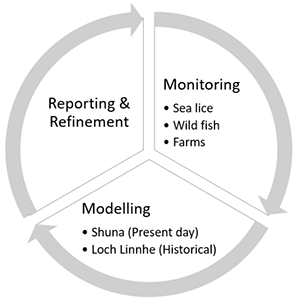Salmon Parasite Interactions in Linnhe, Lorn and Shuna (SPILLS): final project report
The Salmon Parasite in Linnhe, Lorn and Shuna (SPILLS) project focused on testing and improving sea lice dispersal monitoring and modelling techniques. The SPILLS Project developed and compared different models designed to predict distribution of sea lice in Scottish sea lochs.
Executive Summary
The Salmon Parasite Interactions in Linnhe, Lorn and Shuna (SPILLS) project was a 2-year, collaborative project (Annex 2) supported by Crown Estate Scotland and involving finfish farm operators (Mowi Scotland Ltd., Kames Fish Farming Ltd.), Argyll Fisheries Trust (AFT), Argyll District Salmon Fishery Board (ADSFB), Fisheries Management Scotland (FMS), the Scottish Association for Marine Science (SAMS), and Government researchers in Marine Scotland Science (MSS). Staff changes during the project led to participation from Scottish Sea Farms Ltd (SSF) in an advisory capacity.
The Project was designed to:
- Inform and refine the sea lice dispersal models which are used to estimate risks posed by sea lice to wild and farmed salmonids in Loch Linnhe, the Firth of Lorn and Shuna Sound region in West Scotland;
- Evaluate the performance of different sea lice dispersal models for application in managing interactions between sea lice and wild and farmed fish.
Sea lice dispersal modelling is a key component for making predictions of sea lice larvae dispersal in the environment (Figure 1). Sea lice dispersal models consist of hydrodynamic models coupled to particle tracking models. Hydrodynamic models simulate time-evolving physical characteristics of a sea area, including movement of water, water temperatures and salinities. Particle tracking models simulate the transport and dispersal of particles (representing sea lice in this case) from sources (existing farms and proposed farms) and the resulting sea lice concentrations in the modelled sea area. Particle tracking models can represent a range of sea lice behaviours, including: the rate of addition of sea lice larvae from farms; the maturation of the larvae from nauplii to the infective copepodid-stage; swimming behaviours; and mortality.
There are multiple particle tracking models in use, including commercially available packages. The Project used three different particle tracking models to predict the lice exposure of fish in different locations in two study areas, the Shuna Sound area; and Loch Linnhe and the Firth of Lorn.
Modelling objectives vary but can be ascribed to three main categories:
i. "Screening" models(US EPA, 2022a), which represent risk as simply as possible. They are designed to triage clear high and low risks, and identify situations that require further assessment (Pendleton et al. 2015). Simple models can make robust, but generally conservative, predictions with limited data.
ii. "Refined" models (US EPA, 2022b) , used to aid decision making or assess regulatory compliance, including in refinement of screening model results where more detailed assessment is required. The models may include a more sophisticated representation of the system being modelled than screening models and require a greater degree of calibration and validation. The level of sophistication and validation for a refined model should be proportionate to the questions being addressed or the decisions the models are intended to support, but ultimately should demonstrate that the model is "fit for purpose" (FWR, 1993).
iii. "Research" models, intended to improve understanding of the system and of the models themselves, with the resulting knowledge being used to support and improve screening and refined models.
The focus of the Project was on the development and evaluation of sea lice dispersal research models used in Scotland and associated field observation methods. Key goals were to assess and improve the models' prediction capability in Scotland, and to establish their suitability for supporting sea lice management and regulation.
The models developed by the Project and the lessons learned can be used:
- To provide data against which to benchmark the performance of screening models.
- To determine the essential processes and model characteristics that need to be incorporated by sea lice dispersal models in Scotland.
- As practical reference material for those developing sea lice models for other areas.
The Project was designed around the conceptual framework shown in Figure 1. By considering modelling and observations together, better predictions of the "current environment" can be made than by using any one element in isolation (Figure 1). This can facilitate appropriate action to achieve a healthier environment. Societal and policy definitions of an acceptably "healthy" environment enable better allocation of resources for management goals. This is part of a wider conversation, not explored within the Project.

The Project provided the first ever systematic cross-comparison of different sea lice dispersal models produced by partners in different sectors (academic, Government, and industry), including validation against field data. The latter included collection and analysis of the following data sources and assessment of their potential for use to validate sea lice dispersal models:
- counts of lice infesting salmon held in moored sentinel cages, which are designed to measure infective pressure of lice on fish;
- lice captured in plankton tows, which are designed to measure sea lice in the water column;
- lice counts on wild-caught fish.
Model variability and uncertainty were investigated, recognising that understanding uncertainties and their contribution to the range and likelihoods of possible outcomes is critical to aid robust decision making (HM Treasury 2015).
The Project was carried out in connected work packages (Figure 2). An outline of the scope of each work package is provided in Annex 1 to this summary.

This document summarises and synthesises the findings detailed in the reports from each of the Project's work packages. It also summarises use and dissemination of the information (Annex 3).
Contact
Email: Meadhbh.Moriarty@gov.scot
There is a problem
Thanks for your feedback